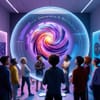Generative AI is taking interactive art to new heights, transforming the way we experience creativity. The latest advancements in this technology are not only enhancing artistic expression but also redefining the boundaries between the creator and the audience.
At its core, generative AI uses complex algorithms to create art, allowing for dynamic and ever-evolving pieces. Unlike traditional static art, these AI-driven works can change and respond to viewer interactions, creating a more immersive and personalized experience. This shift is opening up exciting new possibilities for artists and audiences alike.
Recent developments highlight how AI is pushing the envelope in interactive art. For instance, artists are now using AI to generate pieces that adapt in real time based on user input. This means that no two interactions are the same, making each experience unique and tailored to the individual. Such technology allows for a deeper engagement with art, inviting viewers to become active participants rather than passive observers.
One notable example is the use of AI to create interactive installations that respond to the emotions and behaviors of the audience. By analyzing data such as facial expressions or movement, these installations can alter their visual and auditory components to reflect the viewer’s state. This kind of real-time adaptability adds a new layer of depth to artistic experiences, creating a dialogue between the art and its audience.
The impact of generative AI on interactive art is also being felt in the world of digital media. Artists are exploring new ways to integrate AI into virtual and augmented reality environments, allowing for even more engaging and transformative artistic experiences. These innovations are making it possible for users to immerse themselves in art in ways that were previously unimaginable.
As generative AI continues to evolve, it promises to bring even more groundbreaking changes to the art world. The technology is not only expanding the creative toolkit available to artists but also challenging our traditional notions of art and interaction. The result is a dynamic and evolving landscape where art and technology intersect in fascinating new ways.


